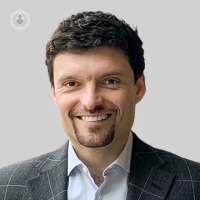Traumatic shoulder instability: Causes, diagnosis and treatment options
Written by:In his latest online article, renowned consultant orthopaedic surgeon Mr Paolo Consigliere delves into traumatic shoulder instability. He offers his expert insight into the causes, diagnosis and treatment options available for patients.

What are the common causes of traumatic shoulder instability?
Traumatic shoulder instability typically results from a sudden injury or trauma to the shoulder joint. Common causes include:
- Shoulder dislocation: This occurs when the upper arm bone (humerus) pops out of the shoulder socket (glenoid). It often happens due to a fall onto an outstretched arm, a direct blow to the shoulder, or a sudden twisting motion.
- Sports injuries: Contact sports like football, rugby, or wrestling can lead to shoulder instability due to the high impact and potential for forceful collisions. Overhead sports like volleyball, tennis, and swimming can also contribute due to repetitive overhead motions.
- Motor vehicle accidents: Trauma from car accidents, especially those involving direct impact to the shoulder region, can cause shoulder instability or dislocation.
- Falls: Falling onto an outstretched arm or directly onto the shoulder can cause significant stress to the shoulder joint, leading to instability.
- Direct blows: Any direct blow to the shoulder, whether from a fall, collision, or other accidents, can damage the structures that support the shoulder joint, increasing the risk of instability.
How is traumatic shoulder instability diagnosed by orthopaedic surgeons?
Orthopaedic surgeons diagnose traumatic shoulder instability through a combination of patient history, physical examination, and imaging studies. Here's an overview of the diagnostic process:
- Patient history: The surgeon will begin by discussing the patient's symptoms, including any history of shoulder dislocations, instability episodes, or previous shoulder injuries. Understanding the circumstances surrounding the shoulder instability events can provide valuable insight into the severity and nature of the problem. The number of dislocations, the age of the first dislocation occurred and the energy needed to dislocate the joint are important information that can predict outcomes and recurrence instability rate.
- Physical examination: The surgeon will conduct a thorough physical examination of the shoulder. This typically involves assessing range of motion, strength, stability, and any signs of instability such as apprehension or apprehension tests, where the shoulder is placed in positions that might provoke instability symptoms, i.e. feeling that the shoulder might pop out of the joint.
- Imaging studies: Imaging studies are crucial for confirming the diagnosis and assessing the extent of shoulder instability. Common imaging modalities used include:
- X-rays: X-rays can help visualise any bone abnormalities, fractures, or dislocations. They can also reveal signs of previous shoulder injuries that may contribute to instability.
- MRI (magnetic resonance imaging): MRI provides detailed images of the soft tissues surrounding the shoulder joint, including ligaments, tendons, and cartilage. It can help identify tears or damage to the labrum (a ring of cartilage that stabilises the shoulder joint) and other soft tissue structures.
- CT (computed tomography) scan: CT scans is very useful in recurrent shoulder instability and is used to look for any bony abnormality or impaction fractures that reduce the socket width or leave a mark on the humeral head. This information is important to define the type of surgery required to minimise recurrence risks.
What are the available treatment options for traumatic shoulder instability?
Treatment options for traumatic shoulder instability are contingent upon several factors, including the severity of the instability, the patient's age, activity level, and overall health. The frequency of dislocations, whether it's the initial occurrence or a recurrent issue, significantly influences decision-making. Recurrent dislocations typically necessitate surgical intervention more often than first-time incidents.
The British Elbow and Shoulder Society (BESS) in collaboration with the British Orthopaedic Association (BOA) has established a protocol for managing first-time dislocations. This protocol tailors the approach based on the age group affected, recognising that the body responds differently to injury with age.
Younger individuals are at a higher risk of recurrent dislocations, often warranting surgical intervention. Conversely, patients over 40 years old may have concurrent rotator cuff injuries, necessitating ultrasound or MRI evaluation to rule out this possibility.
For patients in the intermediate age group, typically between 25 and 40, conservative management with physiotherapy tends to yield favourable outcomes.
Here are some common treatment approaches:
Conservative management
Rest: Avoiding activities that aggravate symptoms.
Physical therapy: Strengthening exercises to stabilise the shoulder joint and improve range of motion.
Nonsteroidal anti-inflammatory drugs (NSAIDs): Medications to reduce pain and inflammation.
Activity modification: Patients may need to modify their activities or sports participation to prevent further shoulder injuries and instability.
Surgical intervention
Arthroscopic stabilisation: Arthroscopic stabilisation involves a minimally invasive surgical approach aimed at repairing damaged or stretched ligaments and tissues within the shoulder joint. This procedure utilises small incisions through which a camera (arthroscope) is inserted to guide the surgical process. In cases where an impaction fracture of the posterior humeral head, known as a Hill-Sachs lesion, is present, there may be a risk of recurrent instability. In such instances, a remplissage technique can be considered. This technique addresses the compression fracture, thereby preventing it from further contributing to levering the shoulder out of the joint.
Open stabilisation: In cases of severe instability or failed arthroscopic procedures, open surgery may be necessary to repair and tighten ligaments and tissues around the shoulder joint.
Bone procedures: In some cases, surgical procedures may involve addressing bone defects or fractures that contribute to instability, such as a Bony Bankart lesion or impaction fracture of the anterior socket bone. Acute anterior bone socket fracture can be addressed arthroscopically with the aim to reduce and fix the fracture. In cases where bone defects may contribute to recurrent instability and surgical failure, it's crucial to consider a bone graft to restore the native bone socket width. Two well-established procedures for addressing bone defects in shoulder instability are arthroscopic bone graft surgery and the Latarjet procedure.
Shoulder replacement: In rare cases of severe damage or chronic instability, shoulder replacement surgery may be considered.
In the second part of this guide to traumatic shoulder instability, Mr Consigliere delves into the rehabilitation and recovery process after receiving treatment. You can find this article here.
Mr Paolo Consigliere is an esteemed consultant orthopaedic surgeon based in London, Keighley, Reading & Cranbrook. If you would like to book a consultation with Mr Consigliere you can do so today via his Top Doctors profile.


